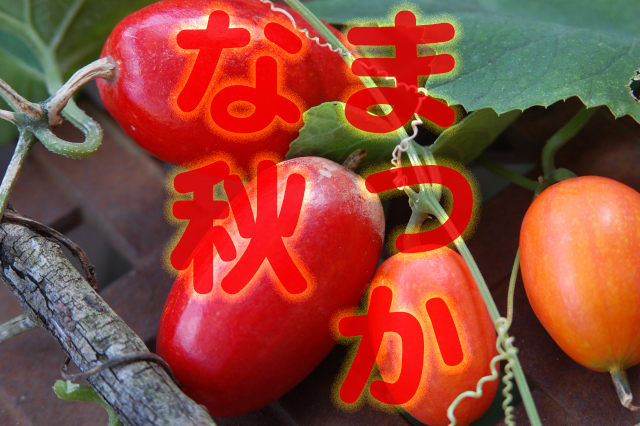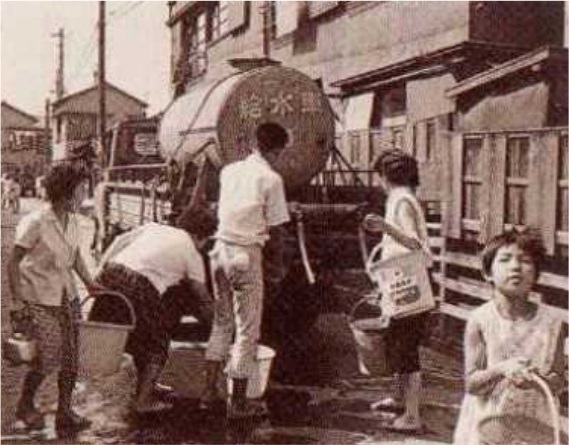Makka na aki
Makka dana
makka dana
Tsuta no happa ga makka dana
Momiji no happa mo makka dana
Shizumu yuhi ni terasarete
Makka na hoppeta no kimi to boku
Makka na aki ni kakomarete iruMakka dana
makka dana
Karasuuri tte makka dana
Tombo no senaka mo makka dana
Yuyake gumo wo yubi sashite
Makka na hoppeta no kimi to boku
Makka na aki ni yobikakete iruMakka dana
makka dana
Higanbana tte makka dana
Tooku no takibi mo makka dana
Omiya no torii wo kugurinuke
Makka na hoppeta no kimi to boku
Makka na aki wo tazunete mawaruLyricist : SATSUMA Tadashi
Composer : KOBAYASHI Hideo
in 1965
Bright Red Autumn
Oh,It’s bright red
It’s bright red
The ivy leaves are bright red
Even the maple leaves are bright red
Illuminated by the setting sun
You and I with bright cheeks
Surrounded by bright red autumn
Oh,It’s bright red
It’s bright red
The snake gourd are bright red
The back of the dragonfly is also bright red
Looking at the sunset clouds
You and I with bright cheeks
Calling out to the bright red autumn
Oh,It’s bright red
It’s bright red
Cluster amaryllis is bright red
Even the distant bonfire is bright red
Passing through the shrine gate
You and I with bright red cheeks
Go around in search of the bright red autumn

“Makka na Aki” (which translates to “Bright Red Autumn”) is a beloved Japanese children’s song that reflects the emotions of children who want to continue playing outside, even as the autumn days grow shorter and the evening approaches earlier. The song captures a moment of childhood innocence and joy, where the change of seasons from summer to autumn brings new experiences and colors, yet also signals the end of long, sun-filled days.

When this song was first introduced in the 1960s, Japan was undergoing a significant period of transformation. The nation was rapidly modernizing, and the rural, natural landscapes known as satoyama (a term used for traditional rural areas where people live in harmony with nature) were starting to decline. This shift was partly driven by the economic growth that followed Japan’s post-war recovery, and the successful hosting of the 1964 Tokyo Olympics, the first ever held in Asia. These events symbolized a turning point for Japan, moving toward urbanization and industrialization, and consequently, the natural environment that children once played in was gradually disappearing.

Despite this trend, the song’s lyrics celebrate the beauty of a fully developed autumn landscape, rich in vibrant colors. The imagery of bright red leaves and crisp autumn air reminds listeners of the nature that still surrounded them in those times, offering children spaces to run and explore. The song can be seen as a tribute to the fleeting moments of nature that were still accessible in a rapidly changing world.
The song was written by lyricist SATSUMA Tadashi and composer KOBAYASHI Hideo, both born in 1931 in Tokyo. When “Makka na Aki” was first broadcast in 1965, both were 34 years old. Their childhood had been marked by the hardships of World War II and the destruction that came with it. Tokyo, the city where they grew up, had been devastated by air raids, and in the years following the war, it underwent a process of reconstruction and modernization. Given this context, it is possible that both creators felt a deep sense of nostalgia for the pre-war natural landscapes of their youth. They may have longed for a time when children could run freely in the countryside, before the pressures of modernization began to alter the city and its surroundings.
This sense of nostalgia, combined with a recognition of the inevitable changes Japan was undergoing, may have influenced the creation of “Makka na Aki.” The song, therefore, does more than just celebrate autumn—it reflects a longing for the innocence of childhood, the beauty of nature, and the sense of freedom that was slowly being lost as the country modernized.
▼A shrine with a beautiful sunset in Tokyo.







コメント